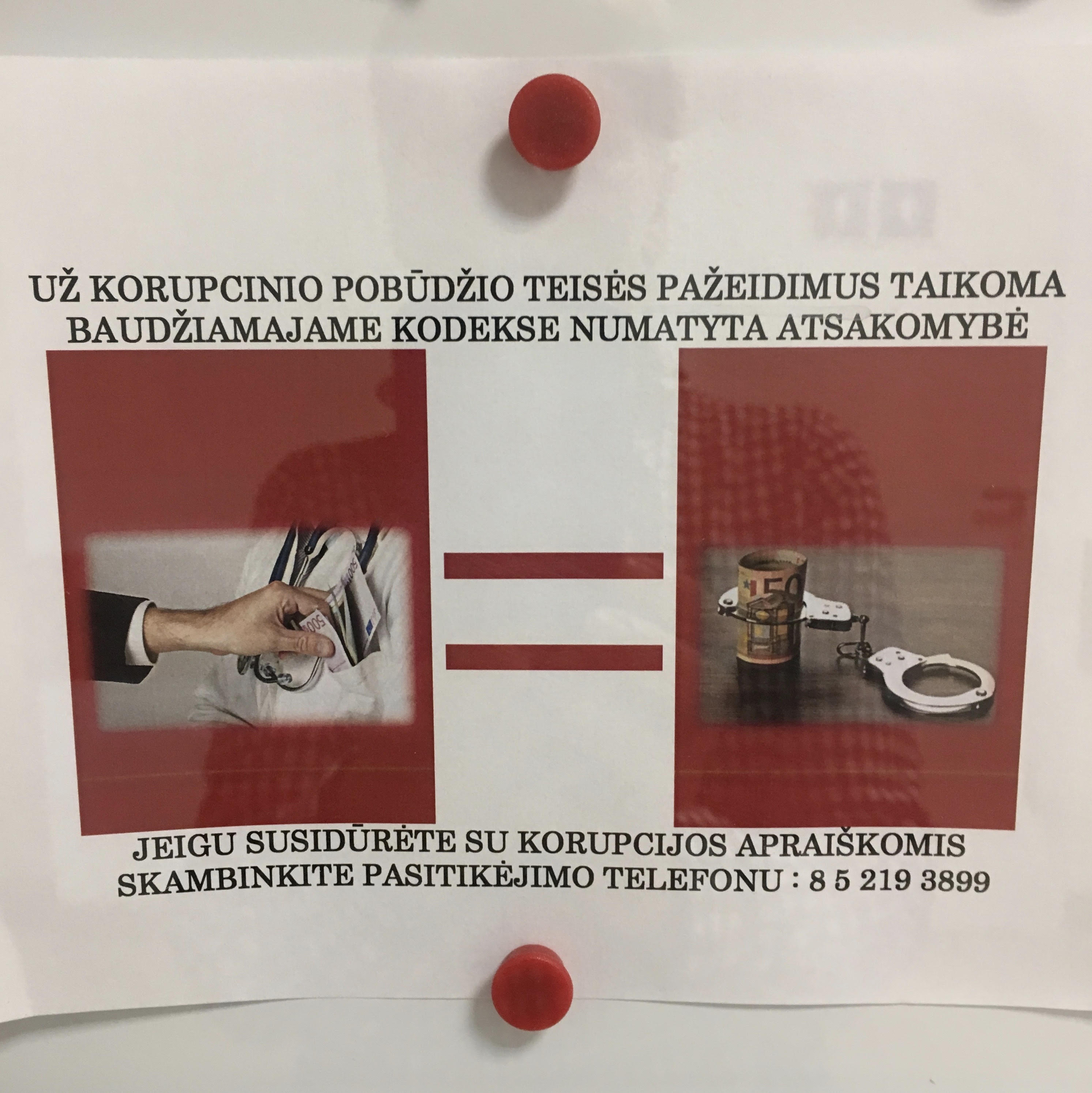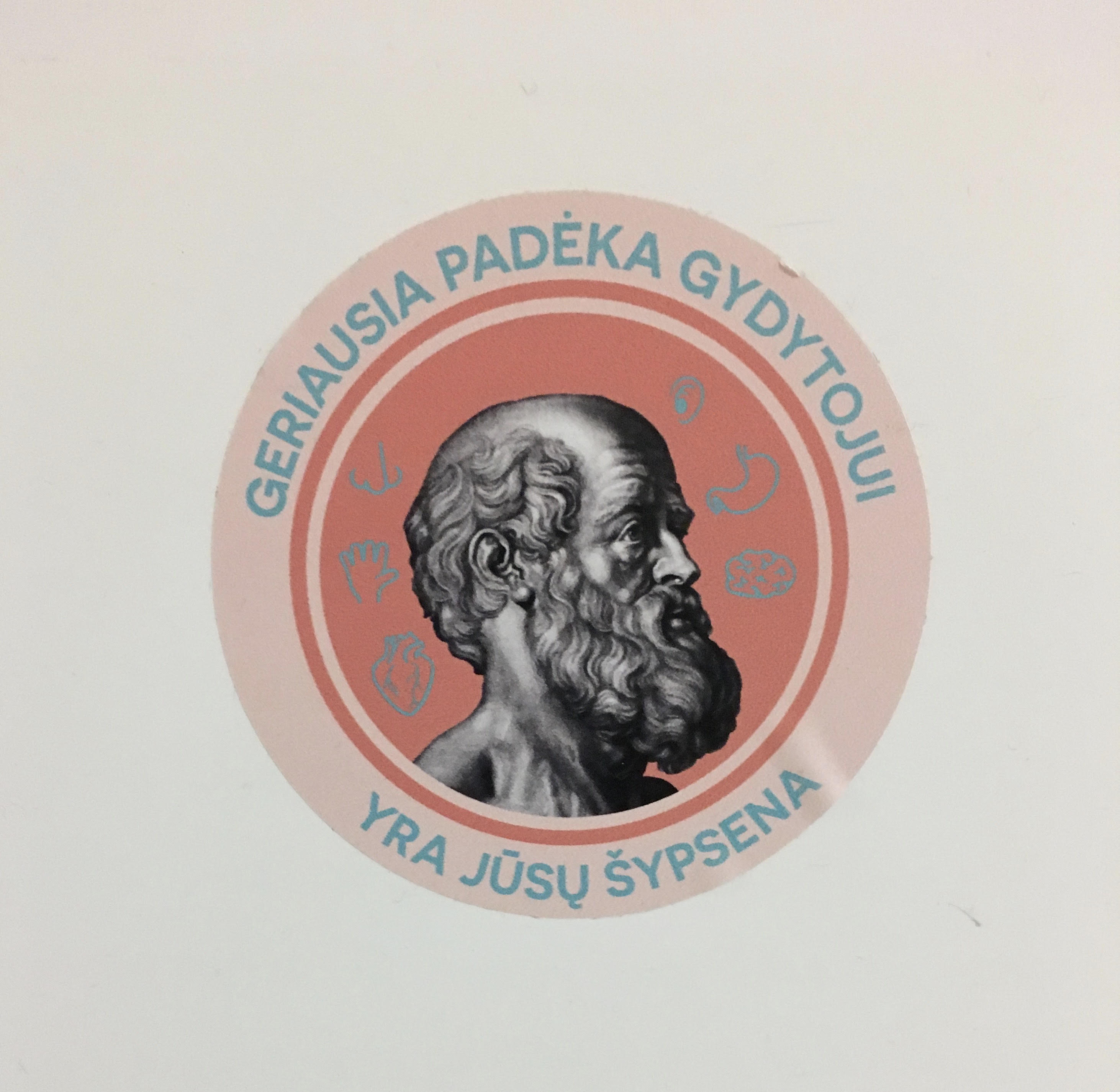Article begins
This summer, a new billboard in Vilnius Old Town, caught my eye. A healthy-looking man was pointing his finger up and informing Lithuanians, “Don’t Believe the Myths—patients are giving bribes less frequently. Know your rights! Lithuanian Corruption Map data shows that fewer patients are giving bribes in health care institutions.” This public service announcement (PSA) was part of the European Union (EU) funded two-year project “Raising intolerance to corruption in health care sector” executed by Cancer Patients Support Association. It didn’t say which corruption map it was referring to or give any numbers. Regardless, this PSA had novel elements: the reference to rights and myth, and the eagerness to show that bribing in public health care institutions in Lithuania was a less common practice than one might think. The message targeted patients and their relatives, who give chocolates, brandy, and envelopes with money to doctors in public health care that different discourses define as gifts, bribes, a form of thank you, or informal payments. How do these campaigns impact medical culture and what results do they hope to achieve?

A public service announcement showing a man wearing glasses and pointing his finger: “Don’t Believe the Myths–patients are giving bribes less frequently. Know your rights! Lithuanian Corruption Map data shows that fewer patients are giving bribes in health care institutions.” Pilies St., Vilnius, Lithuania. June 2019. Rima Praspaliauskiene
Informal payments given by patients to doctors are a distinctive element of medical culture in Eastern Europe and other post-socialist contexts. They have been linked to the scarcity of resources in socialist economies and to the turbulent transitions to capitalism, both working against and sustaining the socialist state. No doubt, these practices do cause anxiety and can be experienced as violent to both patients and doctors. In my forthcoming book, I focus on the envelopes containing money that patients or their relatives give doctors for treatment in the public health care system and show how this complex practice of giving interrupts the process of neoliberal health care reforms.
For the last decade, I have been following these campaigns targeting what some call “bribes” in public health care. These campaigns, funded by the EU, seek to change the relationships between patients and doctors. There are different ways that this change is being envisioned. Since the 2000s, anti-corruption campaigns were coupled with the privatization of health care. They went hand in hand with reform projects that aimed to turn the money in the envelopes that patients gave to doctors into transparent co-payments—channeling the money into the development of private health care. At times, the aesthetics of money was more important than its economic value.
Most of the earlier campaigns were initiated and implemented by Transparency International Lithuania (TIL). In 2004, when Lithuania became a member of the EU, TIL circulated a video PSA called “Don’t Bribe,” which, in a grotesque way, showed how patients were competing with each other to give more money to a surgeon in order to get medical care. The video portrayed a surgeon who was only interested in money and showed him throwing out a patient who was already on a gurney and being rolled into the operating room. The doctor instead operated on another patient who arrived with a briefcase full of money. That video ended with the message, “Bribe is not a guarantee. There will always be someone who will give more.” When I showed this video to my interlocutors, people usually laughed. They did not think the video was depicting the existing reality, but rather a possibility of a future private health care system, when one might need a briefcase of money in order get medical care. The activists from TIL also acknowledged to me that these campaigns were not working.

A PSA poster that reads, “Corruption is a crime prosecuted by the Code of Criminal Procedure. If you encounter any signs of corruption, please call this trusted line”. Vilnius, Lithuania. 2017. Rima Praspaliauskiene
By 2016 and 2017, I had started noticing changes. Doctors were telling me about the seminars that they had to attend. They often joked about these lectures that were supposed to inform them of what a bribe was. Public health care institutions created Corruption Prevention Units and put up announcements informing patients that giving doctors envelopes with money or other gifts was a crime. The announcements provided phone numbers to report any corrupt activities. Yet, when I sat at one of the outpatient clinics in Vilnius, none of the patients passing by even looked at the announcement board. In contrast to earlier campaigns, the Ministry of Health and the Association of Medical Students used different language. These announcements no longer had the undertones of denunciation, but rather acknowledged the practice of giving envelopes and emphasized patients’ desire to thank the doctors. Giving boxes of chocolates and envelopes of money to the doctors was unnecessary; it was enough to smile, say “thank you,” or write a note. The message targeted patients and their relatives, who give chocolates, brandy, and envelopes with money to doctors in public health care that different discourses define as gifts, bribes, a form of thank you, or informal payments.
Stickers with the message “A smile is the best gift to your doctor” were on almost every door at the Vilnius hospital and outpatient clinic in 2017. “Do patients continue to bring envelopes?” I asked family doctor Loreta, who also had the sticker on her office door. “Sure,” she said, confirming that she continued getting money and chocolates. “But what about the stickers,” I asked. She smiled, shook her head and recounted how one of her patients came in on the day after every TV station in Lithuania ran a report about the anti-corruption campaign: “So, the next day he comes in and gives me the box of chocolates. I say to him ‘haven’t you seen the report on TV yesterday—I cannot take anything from you.’ He went mad, ‘This is my gift to you from the bottom of my heart and none of those idiots on TV can tell me what to do—whether I can say thank you to my doctor or not! This is my gift. I never go empty-handed; I can’t. You cannot refuse, my doctor.'” Another time, Dr. Loreta had to raise her voice and order a patient to put back the sticker that he had taken down. The man was angered by its message. These stickers were not working, according to the doctor; smiles are not something that Eastern Europeans are known for.

A sticker on the door of a medical office contains an image of Hippocrates and reads “A smile is the best gift to your doctor.” May 2017. Rima Praspaliauskiene
But patients were giving less money, many doctors told me. And the reason was not the stickers but the euro. In 2015, Lithuania joined the Eurozone. The Lithuanian national currency Litai had been pegged to the euro at a stable exchange rate for the past decade (3.45 litai to 1 euro); therefore, the change in banknotes was only aesthetic—the new euros had different iconography and smaller numbers. Lithuanians were familiar with euros, so the transition to the euro initially went smoothly. However, similar to other countries, Lithuania experienced a spike in prices with the introduction of the euro. Very soon, the numerical prices in euros became almost equivalent to those in Litai, which meant that prices doubled or tripled.
Patients, who used to give their doctors 20 or 10 litai, were confused. Now 20 litai was 5.80 euro, 10 litai became 2.90 euro and 2 euros was a metal coin, which aesthetically isn’t suitable as an offering. Rounding up to 10 euros meant doubling the usual intended amount. That seemed too much when translated back into litai. At times, the aesthetics of money was more important than its economic value. Patients whom I talked to constantly translated euros to litai. They often decided to give less frequently. They continued to receive medical care.
When I returned to Lithuania in 2019, doctors confirmed to me that they were receiving envelopes containing 5, 10, and 20 euros. They also received more produce: fresh potatoes and cucumbers from their patients’ gardens. Patients are giving more but less frequently, which is almost the same as it used to be. We might believe the myths or not, but either way, they shape how we think. Perhaps it is better to believe that patients are giving less. That way, there is no reason to transform public health care into a private enterprise.
Rima Praspaliauskiene is currently a Fellow at Imre Kertesz Kolleg, Jena University, Germany. She is a recipient of the Webber Grant Hunt Postdoctoral Fellowship. Her research investigates relationships between health, care, and money in post-socialist Lithuania in a time of neoliberal reform. Her work has appeared in Medical Anthropology Quarterly, Ethnologie Française, and the blog Somatosphere.
Please send your comments and ideas for SMA section news columns to contributing editors Dori Beeler ([email protected]) and Laura Meek ([email protected]).
Cite as: Praspaliauskiene, Rima. 2019. “Fieldnotes on Bribes, Smiles, and Myths.” Anthropology News website, October 31, 2019. DOI: 10.1111/AN.1296

